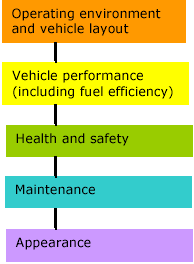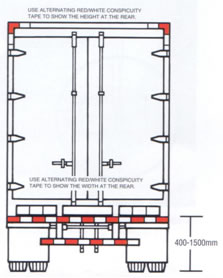
This guide is designed to help you, as a heavy vehicle purchaser, choose the right vehicle to improve your business's efficiency, safety and – ultimately – profitability.
The purchase or lease of a new vehicle can add real value to your operation. For example, you'll probably want to boost the vehicle's payload capacity and/or reduce maintenance costs. Choosing a more fuel-efficient vehicle may also be a priority. The right vehicle can help enhance your business image with your customers and you may also want to consider driver preferences. And, of course, there are the basics – improved safety and increased reliability.
When selecting a new or replacement vehicle, it is advisable to consider the lifecycle cost of the vehicle, not just the initial purchase price. What's really important is to minimise all of the direct and indirect expenses throughout the life of the vehicle. Choosing the cheapest vehicle on the market today may prove to be false economy tomorrow.
The graph below shows the cost of operating a vehicle over its life. The point marked 'Replacement' indicates the stage at which the cost of operating the vehicle is greater than replacing it. This point varies according to the resale value of the vehicle purchased. The lower part of the graph shows different factors that contribute to the vehicle's value over time.

Both the direct and indirect costs associated with operating a heavy vehicle need to be considered when making your selection.
 [GIF, 14 KB]
[GIF, 14 KB]
There are five broad areas that should be considered when purchasing or leasing a vehicle. These are shown below.

The first step is to determine what the vehicle will be used for, the conditions it will regularly be operating under and any other operational or legal constraints. This information will provide the basic requirements for the vehicle including the type of loads that it will be able to carry, how much deck space is required, the type of body to be fitted and how loads will be secured. Don't forget to consider requirements such as road user charges (RUC), static rollover threshold (SRT) and the Land Transport Vehicle Dimensions and Mass Rule - as these will affect the vehicle's configuration including the number of axles, deck length and suspension.

Begin by considering the load space requirements when working out the configuration. Engine size doesn't matter - that comes later.
Assess your proposed vehicle's nominal SRT using the default values in the SRT calculator.
The following links take you to information in this site about legal requirements affecting vehicle layout:
Overall vehicle performance has a major impact on the success of an operation. Once the basic layout of the vehicle has been decided, the next task is to consider specific factors affecting performance, such as engineering and vehicle components. Some of these are required by law to meet vehicle standards (see Vehicle classes, standards and rules).
Pay particular attention to engine power, torque requirements, transmission gearing, differential ratios, wheels and tyres. You should aim to ensure that there is sufficient power available to handle the work required using the least amount of fuel and with the lowest-possible life cycle costs. Another area to consider is investment in braking technology - for example, ABS brakes can reduce wear on brake pads as well as offering additional safety benefits.
Vehicle performance is also affected by the engine cooling system, exhaust system, air conditioning and other engine and transmission-related equipment.
With fuel typically accounting for over 11 percent of the cost of operating a vehicle, any savings in fuel use can make a significant difference to vehicle operating costs. A saving of 10 percent in fuel costs can affect profitability by as much as 30 percent.
There are a number of ways in which vehicle fuel usage can be reduced:
There are a number of road safety and occupational safety and heath issues that must be taken into account. These can be divided into the following groups:
Other features that can increase safety for your drivers and other road users include daytime running lights and conspicuity tape. Also consider ways of reducing noise and emissions for a healthier working environment both in the cab and around the loading bay. Certification requirements also need to be addressed.

The Land Transport NZ Heavy vehicle visibility code is available from our Helpdesk. Email info@nzta.govt.nz.
When purchasing a vehicle, you also need to ensure all legal requirements are met, as specified in the traffic regulations, the Land Transport Rules and the Health and Safety in Employment Act (HSE).
Maintenance is an important consideration when selecting a new vehicle as maintenance (excluding lubricants and tyres) typically makes up 5-10 percent of operating costs. Maintenance costs typically increase as the vehicle gets older and will be higher if the vehicle is routinely operated in harsh conditions.
Infrequent servicing of vehicles may save on maintenance costs in the short-term but is likely to result in breakdowns, which are expensive, not just in terms of repair costs, but in terms of the cost of delayed delivery to your clients.
So, adopt the aim of having zero breakdowns through appropriate vehicle selection and regular maintenance programmes. Ask around to see if the vehicle you are considering is regarded as reliable by other operators. Consider features that improve reliability, such as the use of synthetic lubricants in axles and transmissions and 'sealed-for-life' bearings.
Appearance and functionality of the vehicle can have a significant effect on attracting business and retaining drivers. Consider choosing a cab layout that will enhance driver comfort and a vehicle style which will appeal to your clients (for example, some clients do not like aggressive looking trucks). Vehicle livery and features not only enhance your company's image but can also ensure the driver feels proud of the vehicle and will look after it.

The checklist below may provide useful guidance when working out the specifications for your next vehicle.
| Estimated total kilometres that will be travelled each year | |
| Types of load to be carried | |
| Location at which vehicle will be based (main depot or secondary depot?) | |
| Accessibility to loading/unloading areas | |
| Number of drivers who will regularly use the vehicle | |
| One-way or return trips? | |
| Expected maximum and average payload | |
| Average daily utilisation of the vehicle | |
| Average daily load factor | |
| Will vehicle be operating on hilly terrain, off-highway, in congestion etc? | |
| Will vehicle be required to operate any additional equipment (eg, Hiab)? | |
| Will vehicle be required to tow a trailer? | |
| Will vehicle stay on the same work for all its operational life? | |
| Will vehicle be required to comply with any specific industry sector requirements (eg, tankers)? | |
| Type of body required to carry the load | |
| Load securing arrangements | |
| What is the best configuration for the intended task? | |
| What are the expected dimensions? | |
| Are the weight and height limits required to comply with SRT workable? | |
| Is the tare mass as low as is practical? | |
| What are the expected axle loadings? | |
| What will the GVM and GCM be? | |
| How will the configuration affect road user charges for that vehicle? | |
| What types of specifications have worked best in previous operations? |
| Is the area at which vehicle is based hilly or flat (startability)? | |
| How steep are the hills that the vehicle is likely to have to negotiate (gradeability)? | |
| Is the vehicle likely to be operated off-road? | |
| What is the main type of road surface the vehicle will be operating on? | |
| What are the temperature extremes? | |
| What are the prevailing winds? | |
| Engine option - eg, fully electronic (fly by wire) | |
| Transmission type (synchromesh, constant mesh, non-synchromesh, automatic, automated) | |
| Final drive ratio | |
| Exhaust (the greater the back-pressure, the greater the amount of fuel used) | |
| Cooling fan (specify the smallest variable speed fan necessary for requirements) | |
| Fuel tank size (carrying excessive amounts of fuel reduces payload capacity and increases running costs) | |
| Radiator shutters | |
| Auxiliary braking (engine brake retarder - what type?) | |
| Type of brakes (ABS, EBS or conventional; drum vs disc) | |
| Running auxiliary equipment when vehicle stationary | |
| Speed limiting | |
| On-board vehicle monitoring | |
| Will cruise control be an advantage? | |
| Type of suspension (air or leaf springs?) | |
| Type of tyre (super single or dual?) | |
| Tyre tread pattern | |
| Central tyre pressure monitoring | |
| Set back or conventionally-mounted front axle? | |
| Conventional or low maintenance hubs and bearings? | |
| Type of cab (full sleeper, day cab, extended cab? COE vs conventional?) | |
| 'Dress up' equipment that improves return on investment | |
| Air conditioning | |
| Type of seating | |
| Will existing drivers need retraining? |
| Brake system, including ABS, EBS, discs vs drums etc? | |
| Under-run protection (sides, rear and front) | |
| Seat belts | |
| Conspicuity | |
| Cab strength under impact (to the ECE 29 standard) | |
| Do the mirrors provide good side and rear visibility? Should the mirrors be heated? | |
| Driver access to the cab | |
| Seat adjustment | |
| Driver comfort | |
| Cab layout | |
| Storage space in the cab | |
| Load securing provisions | |
| Lifting equipment such as tail lifts |
| Service intervals | |
| Cost of service and parts | |
| Lubricants | |
| Service support package (if outsourcing maintenance) | |
| Sealed-for-life bearings | |
| Availability of parts | |
| Reliability and expected life of components | |
| Compatibility with other vehicles in your fleet | |
| Knowledge of staff undertaking the repairs | |
| Expected life cycle cost of maintenance |
| Styling | |
| Signage | |
| Driver preference | |
| Brand promotion | |
| Client requirements | |
| Overall image |
Use the axle weights calculator in this guide to calculate axle weights.